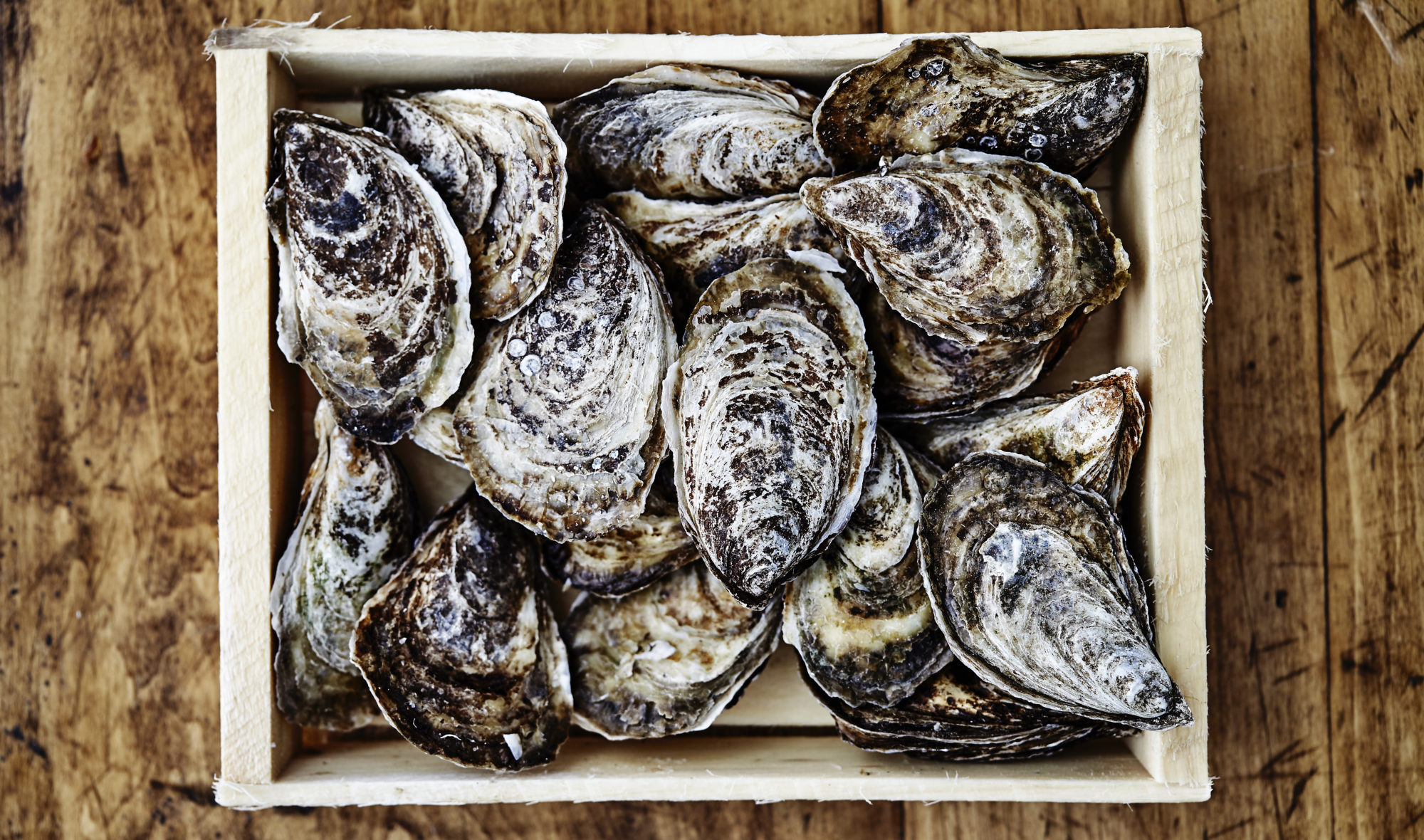
🎁 Holiday Special: SAVE 52% on the Nutrition Coach Starter Package. Limited number remaining.

🎁 Holiday Special: SAVE 52% on the Nutrition Coach Starter Package. Limited # left.

Oysters, rumored for their aphrodisiac powers, are a delightful, if not polarizing, delicacy. Purists enjoy them raw and straight from the shell without a drizzle or dash of condiment or seasoning, enjoying the slippery, fleshy texture, and the refined, oceanic flavour. Oysters are exceptionally rich in zinc, and are also an excellent source of B12, iron, and selenium. Oysters are particularly sensitive to polluted waters, but still thrive in parts of the Pacific and the Northern Atlantic Ocean. Although shucking oysters requires both care and effort, once they are dissembled, eating them is as simple as tipping the shells towards your mouth, and slurping them down.
Oysters are members of the wibbly-wobbly family of invertebrate molluscs, which also includes snails, clams, and squid.
Enclosed between two rough, irregular shells is a soft delicacy humans either love or hate. Oysters have been eaten since prehistoric times, and were first cultivated on a large scale by the Romans.
In addition to being a source of food, oysters also produce fashion accessories: pearls. Small pieces of shell or sand get lodged inside the oyster, and in order to protect itself from this foreign body, the oyster secretes a pearlescent fluid called nacre that calcifies in layers to form a pearl. Although all oysters can produce pearls, some breeds are better than others, and therefore “pearl oysters” are distinguished from “food oysters”.
Some breeds of oysters can be either male or female, but they can also swing; it is not unusual for an oyster to change gender at least once over the course of its life. Other breeds are hermaphrodites and host both male and female anatomy, and can therefore fertilize their own eggs.
The most common and heavily harvested breeds include the Eastern American oyster, found in the Atlantic Ocean from Canada to Argentina, and the Pacific oyster, found in waters between Washington state and Japan, extending South towards Australia.
Oysters are particularly sensitive to polluted waters, and oyster populations have dwindled in some areas where they used to be abundant.
Oysters are also famously known to be aphrodisiacs. (Except for the people who shudder at the thought of eating them.)
The edible portion of the oyster is enclosed between two rough, irregular, oval-shaped scalloped shells. The interior of the shell is smooth and porcelain-white with a mother-of-pearl iridescence.
The soft muscle of the oyster is fused to the interior of the shell, and must be detached with a knife before eating. The meat, when raw, is jelly-like and irregularly shaped with a marbling of colors that range from grey to beige to white.
Raw oysters have a refined, mild oceanic flavor that varies from oyster to oyster depending on the species, the region from which it came, and the time of year it was harvested. Some oysters are sweet and fruity, while others are more briny or mineral tasting.
Cooking oysters will bring out a savory, fishy flavour. The meat will lose its slipperiness; however, unless it is overcooked, it will still be delightfully tender.
A serving of six medium-sized oysters (about 84g) has 43 calories, 4.8 grams protein, 1.4 grams of fat, 2.3 grams of carbohydrates, 0.5 grams sugar, and no fiber. Oysters are exceptionally high in zinc, and are also a rich source of vitamin B12, iron, and selenium.
Oysters are usually best purchased at specialty seafood markets staffed by trustworthy fishmongers that are known for consistently providing quality products.
Oysters can purchased raw, either live and still in the shell, or already shucked. Shucked oysters may also be found frozen. Additionally, canned smoked oysters can be found in many large grocery stores and gourmet food shops.
If you are buying live oysters in the shell, look for shells that are undamaged and shut tight. If you find one that is slightly open, tap it. If it is alive, it will close promptly and firmly. The shells should feel nice and heavy, as healthy ones will be full of seawater.
If you are buying fresh shucked oysters, find those that appear shiny, fleshy, and firm. The liquid they are stored in should be clear, not milky, and should not have any sour or unpleasant odor.
Many oyster aficionados proclaim that fresh oysters are best harvested during months that contain the letter “r”. Rumor has it that the coldest water yields the tastiest oysters.
For best flavor and safety, live oysters should be kept on a bed of ice and be eaten within a few hours after purchasing.
Oysters that have already been shucked and whose meat is stored in its own liquid are also best eaten sooner rather than later, but can last up to a week in an airtight container in the fridge.
Once they are cooked, they will keep in the fridge for up to three days.
Whether raw or cooked, oysters can also be frozen. In a well sealed container, they can last in the freezer for up to three months.
Like most canned goods, canned smoked oysters have a very long shelf life. Follow the expiration dates on the label.
Live oysters can be slurped up without a drip or dash of seasoning or condiments, but first you have to open them, which takes some skill.
If you can, have your fishmonger do the shucking for you. Otherwise, follow these directions:
First, run the shells under cold water and scrub off any sand or debris. Then, hold the oyster shell with a clean cloth. The cloth is there to prevent slipping and to protect your hand should the knife slip (which it tends to do during this task). Use a shucking knife or a (not too sharp) paring knife, and insert the blade between the two shells, near the hinge. Twist the knife until the shells pop apart; this may take a bit of effort and wiggling. Twist off the top shell, detaching any meat with a sharp knife. Repeat this for the bottom shell, sliding the blade of the knife under the muscle to detach it from the shell.
Purists will recommend eating the oyster as is, while others prefer a squeeze of lemon, some hot sauce, or a simple vinaigrette.

Fresh oysters are simple and delicious on their own, but with these three easy to make sauces, they are an exciting and exotic treat.
Prep Time: 25 minutes Cook Time: 0 minutes Yield: 12 servings per sauce
Sauce 1: Mango Chili Sauce
Add all ingredients to a jar and whisk to combine. Make sure honey is completely dissolved before serving.
Once the sauce is ready, spoon small amounts of it onto a fresh shucked oyster, and slurp it up.
Sauce 2: Cucumber Ginger Lime Sauce
Add all ingredients to a jar and whisk to combine. Make sure honey is completely dissolved before serving.
Once the sauce is ready, spoon small amounts of it onto a fresh shucked oyster, and slurp it up.
Sauce 3: Sesame Green Onion Sauce
Add all ingredients to a jar and whisk to combine.
Once the sauce is ready, spoon small amounts of it onto a fresh shucked oyster, and slurp it up.
Precision Nutrition’s Encyclopedia of Food expands every single month as we highlight new foods and showcase beautiful food photography. If you’d like to stay up to date, simply click this link. From there, we’ll send you a FREE copy of our recipe book. We’ll also let you know when new and delicious foods are added to the site.
Oysters, rumored for their aphrodisiac powers, are a delightful, if not polarizing, delicacy. Purists enjoy them raw and straight from the shell without a drizzle or dash of condiment or seasoning, enjoying the slippery, fleshy texture, and the refined, oceanic flavour. Oysters are exceptionally rich in zinc, and are also an excellent source of B12, iron, and selenium. Oysters are particularly sensitive to polluted waters, but still thrive in parts of the Pacific and the Northern Atlantic Ocean. Although shucking oysters requires both care and effort, once they are dissembled, eating them is as simple as tipping the shells towards your mouth, and slurping them down.